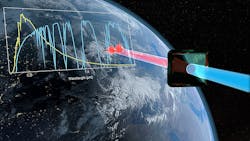Quantum-entangled photons at 2.1 μm wavelength are superior for space-to-Earth communications
A 15-member research team from the UK, Germany, and Japan has developed a new method for generating and detecting quantum-entangled photons at a wavelength of 2.1 μm.1 Entangled photons are used in encryption methods such as quantum key distribution to completely secure telecommunications between two partners against eavesdropping attempts.
Until now, it has been only technically possible to implement such encryption mechanisms with entangled photons in the near-infrared range of 700 to 1550 nm. However, these shorter wavelengths have disadvantages, especially in satellite-based communication: They are disturbed by light-absorbing gases in the atmosphere as well as by the background radiation of the sun. Using existing technology, end-to-end encryption of transmitted data can be guaranteed at night, but not on sunny and cloudy days.
The international team, led by Matteo Clerici from the University of Glasgow (Glasgow, Scotland), wants to solve this problem with its discovery. The photon pairs entangled at a 2.1 μm wavelength would be significantly less influenced by the solar background radiation, says Michael Kues from the PhoenixD Cluster of Excellence at Leibniz University of Hannover (Hannover, Germany). In addition, transmission windows exist in the earth's atmosphere, especially for wavelengths at around two micrometers.
For their experiment, the researchers used a lithium niobate nonlinear crystal. They sent ultrashort laser pulses into the crystal; a nonlinear optical interaction produced the entangled photon pairs with the new wavelength of 2.1 μm. "The next crucial step will be to miniaturize this system by converting it into photonic integrated devices, making it suitable for mass production and for use in other application scenarios," says Kues.
The PhoenixD Cluster of Excellence
Between 2019 and 2025, the Cluster of Excellence PhoenixD, led by Leibniz University Hannover, will receive approximately 52 million euros of funding from the federal government and the State of Lower Saxony via the German Research Foundation (DFG). The cluster is a collaboration of TU Braunschweig, Max Planck Institute for Gravitational Physics (Albert Einstein Institute), Physikalisch-Technische Bundesanstalt, and Laser Zentrum Hannover e.V. Within the scope of the cluster, more than 100 scientists from the fields of physics, mechanical engineering, electrical engineering, chemistry, computer science, and mathematics conduct interdisciplinary research. The cluster explores the possibilities offered by digitization for novel optical systems as well as their production and application.
Source: https://www.uni-hannover.de/en/universitaet/aktuelles/online-aktuell/details/news/physicist-from-hannover-develops-new-photon-source-for-tap-proof-communication/
REFERENCE:
1. S. Prabhakar et al., Science Advances 6, eaay5195 (2020); https://doi.org/10.1126/sciadv.aay5195.
About the Author
John Wallace
Senior Technical Editor (1998-2022)
John Wallace was with Laser Focus World for nearly 25 years, retiring in late June 2022. He obtained a bachelor's degree in mechanical engineering and physics at Rutgers University and a master's in optical engineering at the University of Rochester. Before becoming an editor, John worked as an engineer at RCA, Exxon, Eastman Kodak, and GCA Corporation.

